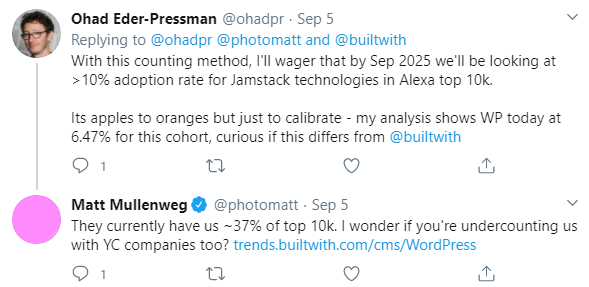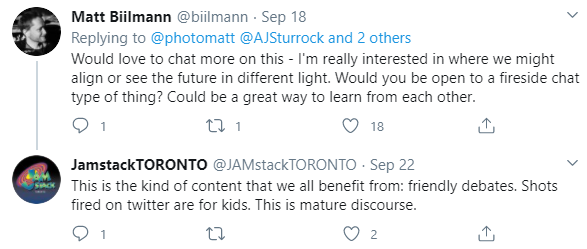It becomes a global buzz when celebrities, politicians, or sports personalities get into the battle of opinions online. When the same word exchange happens between the developers, designers, or tech-savvy people, anybody hardly notices it or ignores it completely. It may not get the limelight it should, but in the developer’s ecosystem, this opinion sharing does hold a place. A discussion about JAMstack and WordPress shares the same fate even when the WordPress co-founder, Matt Mullenweg, shared his views on JAMstack in an email to Richard MacManus.
"JAMstack is a regression for the vast majority of the people adopting it; the usability and functionalities are actually lower. Even rebuilding sites in JAMstack harkens back to the Movable Type days, where the bigger your site gets the slower it is to rebuild or update templates."
And soon as this was made, the backfire was inevitable. Stackbit's co-founder and CEO, Eder-Pressman was the first one to do it.
“The achievements of WordPress in terms of market share and how it democratized early web publishing are amazing. When it comes to architecture I think it was best in class for the early 2000s but it’s time to move forward. We already see cohorts of websites where Jamstack adoption crosses 20% – it’s no longer a question of if the Jamstack becomes the predominant architecture for the web but a question of when. The cliche is a cliche but it also rings true – First, they ignore you, then they laugh at you (we are here), then you win.”
He did agree with Matt Mullenweg on the point that JAMstack lacks functionality and usability but also said that its architecture is infinitely more resilient.
The next one in the line is another Matt, another important Matt. He is Netlify CEO Mathias Biilmann. The term ‘JAMstack’ was coined by him.
“There’s often a moment right around the time when an old technology is about to be displaced by the next thing, where the main leader in the field goes out and makes a strong argument that absolutely nothing is happening,” Biilmann said. “A moment that ends up looking like a turning point where the new was undeniably present enough to be worth being in denial about.”

Before sharing our views on that, let's take a look at both the technologies.
JAMstack - What's in it actually that people love
JAM in JAMstack stands for JavaScript, APIs, and Markdown. You might have noticed that all these are open source, which makes it a playground for web developers without any paid ticket. Web developers combine these techs and others to build fantastic websites for them or their clients. JavaScript is utilized on both the server and browser side. However, in the case of JAMstack, JavaScript is dedicated on the browser side. Markdown content is a specialized text format. It is one of the ways of writing rich text using simple commands while making a website in JAMstack.
JAMstack uses and connects these technologies to equip web developers for a great website building experience. In a world that is obsessed with WordPress, JAMstack had to bring something exciting on the table, which it actually did.
- JavaScript is used for building reactive web pages
- APIs are used for the data source and user interaction
- Markdown is used for creating content.
Users have the option to manually use these or use a static site generator instead. Static site generators simply pull the content from your Markdown files and other data from headless CMS using APIs. Then the static site generator creates the HTML pages for the website based on that content pulled. Those pages may or may not include JavaScript and other styles.
The User Experience of JAMstack and What Happens at the Backend
The static site generators have advanced pre-generated HTML pages, which are good for SEO. You can embed JavaScript code on them as per your page's requirements. As the users visit your website, JAMstack websites load the pre-generated HTML pages, which are super quick, then the embedded JavaScript code is fired. This happens for every page making your website superfast. Speed is an important ranking factor, and JAMstack websites have good SEO by default. This makes this approach popular.
You have high reactivity of the single page websites that start as a server-side rendered application where the search engine can parse all your content efficiently and quickly. Gatsby, Next.js, Gridsome, Hugo, Jekyll, Scully, are some of the static site generators.
Major Benefits of JAMstack
You get speed, security, development workflow. You don't need to manage your own backend server. You don't have to run your own database. They are secure because system administrators generate the web pages, so code injection is tough.
Everything seems good about JAMstack and static site generators. Then why there's backlash for this technology shown especially by WordPress's co-founder founder and CEO?
Disadvantages of JAMstack
"Technically, JAMStack is good for small websites that don't need rebuilding templates every time an update is made like the case with WP. It leads to a disadvantage where advantage was the objective of signing up for it, making it load faster. The bigger the site, the more it gets harder to maintain and rebuild static pages, hence, a disadvantage." - Haseeb, Computan
WordPress
WordPress, and other CMS of the family such as Magento, Joomla, Drupal, Shopify make dynamic websites, and unlike in static site generation, these fetch the complete PHP pages, which are heavier than the static HTML pages.
You install WordPress, write content, add images, add title, and it's all there. Set its SEO via plugins, review it, and publish it. This is the stuff that a non-developer can do. And oh! You missed the social icons. You add social media plugins to connect your social channels to your website. It is all drag and drop, click, and tick. Whatever you do there, WordPress stores that in a database application, MySQL, most of the time.
When you have a visitor on that page, WordPress will fetch that page from the database. The issue is that it takes a lot of resources. Application, database, memory, and resources make it an expensive operation to maintain and operate, but only when compared to JAMstack.
A server loads a static page built through a static site generator, in a flick. You create an article on a static website through a static site generator, then it creates an HTML page of your article, and it will put it on a server in a directory. So, when somebody comes to read your article, it just goes to that page directly because it is pre-created by your static site generator application.
It just grabs the page. It doesn't open and establishes a connection every single time.
The advantage is that you can generate many more pages with much less server power. Now, if you have to list multiple interrelated articles, you can configure your system that will automatically update all the pages where that link needs to be. With 100 pages, the system has to update all the linked pages, so it takes a lot of time every time you upload a page and interlink them. More the pages, the more the time because your static site generator has to go through all the pages to update them. Here, the time is drastically reduced by WordPress CMS.
The static site generator is not fit for all kinds of pages. A page that constantly changes, like a newsfeed page that has changed every minute or the shopping cart page that needs to be built dynamically with randomly chosen products for every single user. Building that complex systems in JAMstack are not friendly. There too, the WordPress CMS takes away the cake.
Another major benefit of WordPress is that you have a big community and apps and plugins in functionality. From having a simple text page to a dynamic shopping cart pages, or give access to only paid membership areas, these things are now done with one hand, and with the other, you can enjoy your donut or coffee.
Computan's Project Manager, Kassem, shares his views on this.
In the early days, people used to create their websites manually by writing the HTML themselves, and each page needed to be created manually and uploaded to FTP. Then, the world got CMSs, and that changed how people manage content. WordPress is the leading example. Now a new trend called JAMstack is going back to creating static sites with a modern flavor. However, JAMstack websites are harder to manage for beginners, so they have to spend on support services, which is a huge disadvantage when we look at WordPress and its learning curve.
The Future
Both Matts have taken the high road and settled to look to the future
Matt Mullenweg “I’m happy to make a long bet: 1 year, 5 years, 10 years, we’re building and rebuilding WordPress to be generational. We’ve navigated and created bigger architectural shifts in the past, and will do so in the future.”
In response to this, Matt Biilmann replied




